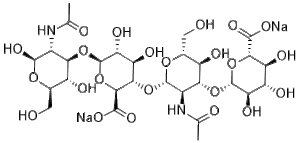Hyaluronate Sodium (Hyaluronic acid sodium; Sodium hyaluronate)
This product is for research use only, not for human use. We do not sell to patients.

For small sizes, please check our retail website as below: www.invivochem.com
| Size | Price | Stock |
|---|---|---|
| 500mg | $450 | Check With Us |
| 1g | $750 | Check With Us |
| 5g | $1900 | Check With Us |
Cat #: V22288 CAS #: 9067-32-7 Purity ≥ 98%
Description: Hyaluronate Sodium (Hyaluronic acid sodium; Sodium hyaluronate), composed of repeating units of disaccharides, is endogenous anionic non-sulfated glycosaminoglycan found in conective tissue and synovial fluid.
Top Publications Citing Invivochem Products
Publications Citing InvivoChem Products
Product Promise

- Physicochemical and Storage Information
- Protocol
- Related Biological Data
- Stock Solution Preparation
- Quality Control Documentation
| Molecular Weight (MW) | 1500 (kDa) |
|---|---|
| CAS No. | 9067-32-7 |
| SMILES Code | CC(N[C@@H]1[C@@H](O[C@H]2[C@H](O)[C@@H](O)[C@H](O[C@H]3[C@H](NC(C)=O)[C@@H](O[C@H]4[C@H](O)[C@@H](O)[C@H](O)[C@@H](C(O[Na])=O)O4)[C@H](O)[C@@H](CO)O3)[C@@H](C(O[Na])=O)O2)[C@H](O)[C@@H] |
| Synonyms | Hyaluronic acid sodium; Sodium hyaluronate |
| Protocol | In Vitro | Hyaluronic acid (HA) is widely used in aesthetic medicine due to its binding ability with a large number of water molecules. It improves tissue hydration and their resistance to mechanical damage. HA plays an important role in wound healing, ovulation, fertilization, signal transduction, and tumor physiology. HA is used in joint diseases such as osteoarthritis or rheumatoid arthritis. HA of a high molecular mass reduces the chemotaxis and migration of inflammatory cells which acts as a good barrier to the inflammatory process and protects against the effects of free radicals. HA is used in ophthalmology due to its lubricating properties for the corneal endothelium, and improves tissue hydration and cellular resistance to mechanical damage in aesthetic dermatology, and has marginal adverse effects. Several trials indicate its role in tumor markers, liver diseases, and in pharmaceuticals. |
|---|---|---|
| In Vivo | The impact of applied intra-articular HA has been proven in many studies in animals. Studies on HA have shown that it promotes the synthesis of cartilage matrix, prevents its degradation, reduces inflammation, stimulates the synthesis of endogenous HA, and improves the resilience and moisture of cartilag. |
These protocols are for reference only. InvivoChem does not
independently validate these methods.
The molarity calculator equation
Mass(g) = Concentration(mol/L) × Volume(L) × Molecular Weight(g/mol)
Mass
=
Concentration
×
Volume
×
Molecular Weight*
The dilution calculator equation
Concentration(start)
×
Volume(start)
=
Concentration(final)
×
Volume(final)
This equation is commonly abbreviated as: C1 V1 = C2 V2
Concentration(start)
C1
×
Volume(start)
V1
=
Concentration(final)
C2
×
Volume(final)
V2
Step One: Enter information below
Dosage mg/kg
Average weight of animals g
Dosing volume per animal µL
Number of animals
Step Two: Enter the in vivo formulation
%DMSO
+
%
+
%Tween 80
+
%ddH2O
Calculation Results:
Working concentration:
mg/ml;
Method for preparing DMSO master liquid:
mg
drug pre-dissolved in
µL
DMSO(Master liquid concentration
mg/mL)
,Please contact us first if the concentration exceeds the DMSO solubility of the batch of drug.
Method for preparing in vivo formulation:
Take
µL
DMSO master liquid, next add
µL
PEG300, mix and clarify, next add
µL
Tween 80,mix and clarify, next add
µL
ddH2O,mix and clarify.
Note:
- (1) Please be sure that the solution is clear before the addition of next solvent. Dissolution methods like vortex, ultrasound or warming and heat may be used to aid dissolving.
- (2) Be sure to add the solvent(s) in order.




































